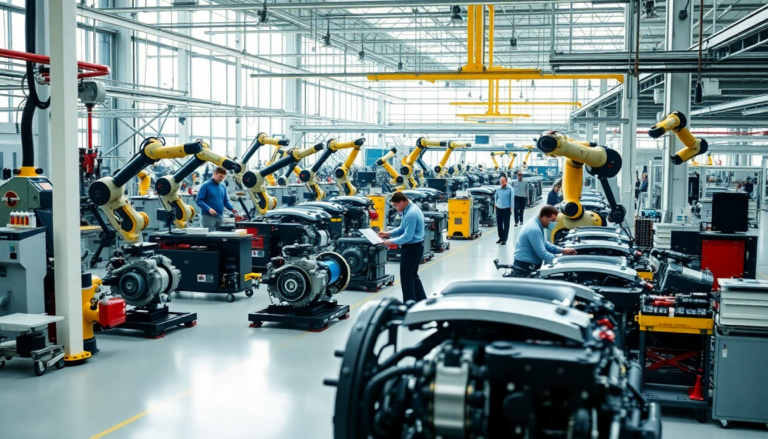Argomenti trattati
The automotive industry is a dynamic blend of innovation and tradition, a world where the roar of engines meets the hum of technology. Imagine standing on an assembly line years ago, watching teams of skilled workers meticulously craft the first horseless carriages. Fast forward to today, and we find ourselves in an era dominated by automation, electric vehicles, and sustainability initiatives. But how did we get here, and where are we headed? Let’s embark on a journey through the evolution of this colossal industry.
The birth of the automotive industry
It all began in the 1860s, a time when inventors were captivated by the idea of creating a self-powered vehicle. The term ‘automotive’ itself derives from the Greek word ‘autos’, meaning self, and the Latin ‘motivus’, meaning of motion. As the first automobile rolled off the assembly line, it was a marvel of engineering, albeit a cumbersome one. Early manufacturing was painstakingly slow, relying heavily on manual labor.
I remember during a visit to a vintage car museum, I marveled at the craftsmanship that went into those early models. The evolution from manual assembly to the assembly line revolutionized production. The introduction of the conveyor belt system in the early 20th century marked a pivotal shift, allowing for mass production and making cars more accessible to the public. This transformation was not just about efficiency; it changed how we viewed transportation. Suddenly, owning a car was no longer a luxury but an attainable goal for many.
From dominance to diversification
For decades, the United States was the undisputed leader in automobile production, with giants like General Motors and Ford dominating the market. By the late 1920s, the U.S. produced over 90% of the world’s automobiles. However, the landscape began to shift dramatically in the latter half of the 20th century. Countries like Japan and later China surged ahead, reshaping global production dynamics.
By 2009, China claimed the title of the world’s largest automobile producer, a feat that was both awe-inspiring and daunting. I recall attending an automotive conference where industry experts debated the implications of this shift. The competition wasn’t just about numbers; it was about innovation. Chinese manufacturers began forming joint ventures with established automakers, leading to a surge in technological advancement and vehicle diversity.
The importance of safety and regulations
In the automotive world, safety is paramount. As vehicles became more complex, so did the regulations governing them. Standards like ISO 26262 have emerged to ensure functional safety in automotive design. But regulations are not merely bureaucratic hurdles; they serve a critical purpose—protecting lives. However, the industry is still grappling with product recalls due to safety issues, which can have devastating financial ramifications.
Once, I read about a major recall that affected millions of vehicles due to faulty airbags. It was a stark reminder that even the most advanced technologies are not immune to failure. Manufacturers invest heavily in rigorous testing and inspections to minimize these risks, but the ramifications of a single oversight can ripple through the market.
Facing the challenges of the future
As we look to the future, the automotive industry faces a myriad of challenges. The push for zero-emission vehicles is reshaping manufacturing processes. The European Commission’s ‘Fit for 55’ legislation is a clear signal that the industry must adapt or be left behind. Major automakers are committing to producing only zero-emission vehicles by 2035, a daunting but necessary shift.
And yet, while many traditional markets are stagnating, emerging markets are rising rapidly. Countries like India and Brazil are becoming significant players in vehicle sales. I recall a conversation with a friend who had just returned from a trip to India, where he noted the explosion of two-wheeler usage. It’s fascinating how cultural shifts can influence automotive trends.
Water consumption and environmental impact
One often overlooked aspect of automotive production is its environmental impact, particularly concerning water usage. Manufacturing a single car can consume over 180,000 liters of water. Processes like painting and cooling are notoriously water-intensive. Recently, I learned about Tesla’s Gigafactory in Berlin facing legal challenges due to its high water consumption. The local government had to balance industrial demands with environmental concerns, a reflection of the broader sustainability debates gripping the industry.
In a world increasingly aware of its environmental footprint, automakers must innovate not just in vehicle technology but also in sustainable manufacturing practices. This includes rethinking resource management and production methodologies to ensure a greener future.
A roadmap for innovation
As the automotive industry continues to evolve, the road ahead is filled with uncertainty and opportunity. From the days of the first automobile to the emergence of electric vehicles, the journey has been nothing short of extraordinary. The integration of advanced technologies like AI, autonomous driving, and smart connectivity is set to redefine our relationship with cars.
Yet, amidst all this progress, one must ponder—what does it mean to own a car in the future? As urbanization rises and younger generations lean towards alternative modes of transport, the automotive industry must adapt. Perhaps, as the saying goes, ‘the only constant is change’. The only question left is: are we ready for it?

